| Das Spindler & Hoyer 6x24 Monokular wurde von der Dänischen Armee, als bekannt wurde, dass Schweden solche S&H 6x24 Modelle erworben hatte, in einer Stückzahl von 20 zur Erprobung bestellt und 1931/32 getestet. Von den Seriennummern 76901-76920 und Militärnummern 1 - 20 ist das vorliegende Belegstück Ser.nr. 76915 Nr. 15. Dies ist auf dem unteren einfach verschraubten schwarz lackierten Messingdeckel graviert; weiterhin ist der Deckel mit der Dänsichen Krone und "HT" - Hærens Tøjhus (Heeres-Zeughaus) - gekennzeichnet, während die später georderten Spindler & Hoyer 6x24 Serienmodelle mit HV bezeichnet sind. Der obere zweifach verschraubte Messing-Deckel ist mit dem S&H-Logo und "6x24" gekennzeichnet. Die angedachte Beschriftung mit "E. Pr. 6x M.1931 (Enkelt-Prismekikkert 6x M.1931)" wurde offensichtlich nicht ausgeführt. Vgl. hierzu M. Simonsen: Hærens Håndkikkerter, in Vabenhistoriske Aarborger 2004, S. 75ff. und S. 98. |
This Spindler & Hoyer 6x24 monocular was ordered by the Danish Army in a 20 piece sample batch, and tested in the years 1931/32. This was the consequence when the military got to know that Sweden hat bought such S&H 6x24 models. Within the sereis form numbers 76901 to 76920 and military numbers 1 - 20 the surviving example here has the ser.nr. 76915 and Nr. 15. Both numbers are engraved on the black painted bottom brass cover which has only one screw; moreover, the Danish crwon and "HT" - Hærens Tøjhus (Army Arsenal) - is engraved on the cover, whereas the later ordered Spindler & Hoyer 6x24 series models have a "HV" marking. The top brass cover comes with two screws. It is inscribed with the S&H logo and "6x24". The proposed inscription with "E. Pr. 6x M.1931 (Enkelt-Prismekikkert 6x M.1931)" apparently was not carried out then. Cf. M. Simonsen: Hærens Håndkikkerter, in Vabenhistoriske Aarborger 2004, p. 75ff. and p. 98. |
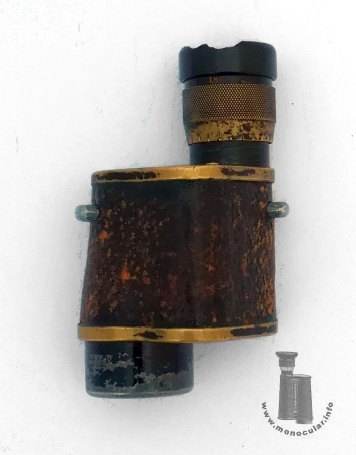
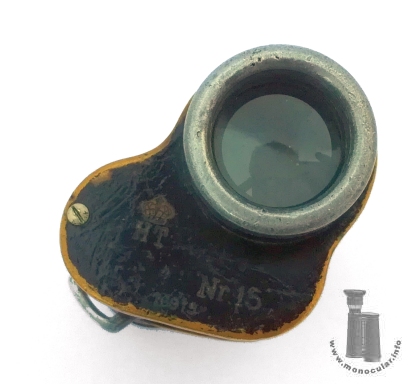
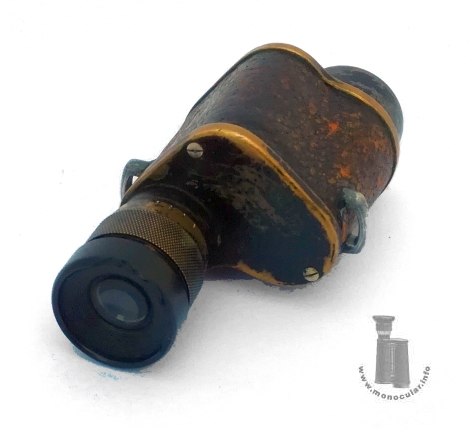
| Das 6x24 hat, abweichend von normalen zivilen Spindler & Hoyer-Monokularen oben gegenüberliegend am lederummantelten Gehäuse 2 Trageriemenösen. Das Okularstück ist noch - im Gegensatz zu den späteren Serienmodellen - mit einer breiteren Bakelit-Augenmuschel, einem kreuz-geriffelten Fokussierungsring und einem Dioptrienring mit einer bei 0, + und - 5 markierten Skala versehen. Das Monokular hat eine Strichplatte mit mittig positionierten, vertikalen eingeteilten Strichen in 5er und 10er Schritten, beschriftet mit 0, 20, 40, 60 und 80. Mittig bei 40 kreuzt eine kurze horizontale Linie die lange vertikale Linie. |
The 6x24 has, contrary to the normal civilian monoculars by Spindler & Hoyer two strap-lugs cast into the leather-covered housing on the opposite upper sides. The eyepiece still has - contrary to the later models - a broader Bakelite eyecup, a knurled focusing ring, and a dioptre ring with a scale which is marked at 0, + and - 5. There is a reticle with vertical division lines in steps of 5 and 10 inscribed with 0, 20, 40, 60 und 80. The lines and numbers are in the centre from left to right. A short horizontal line at 40 corsses the vertical longer line. |
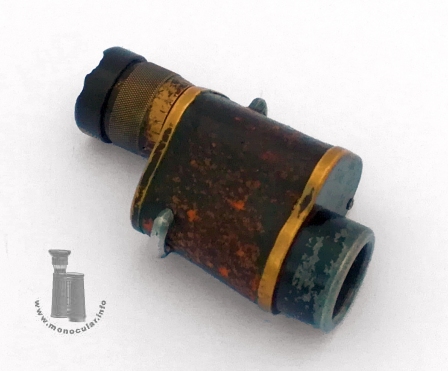
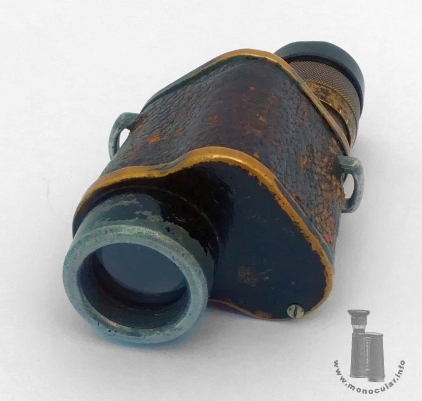

| Durch die Augenmuschel ist es noch etwas länger als später: 103 bis 111 mm. Die Messingdeckel sind oben zweifach, unten einfach veschraubt. Die Objektivfassung ist aus Aluminium. Das Gehäuse ist oben 49x49 mm und unten 54x54 mm breit. Die Objektivfassung ist 33 mm, das Okularstück 26 mm, der glatte Fokussierungsteil 31 mm und die Augenmuschel 33 mm im Durchmesser. Das Glas und wiegt 262 g. | Because of this eyecup type the monocular is longer than later: 103 to 111 mm. The brass covers have two screws on the top and one on the bottom plates. The housing measures 49x49 mm at its top and 54x54 mm at its bottom. The black lacquered aluminium objective frame is 33 mm, the eyepiece 26 mm, the knurled focusing ring 31 mm, and the eyecup 33 mm in diameter. The 6x24 weighs 262 g. |
Fotos: Zeun; 1-4 Ebay

